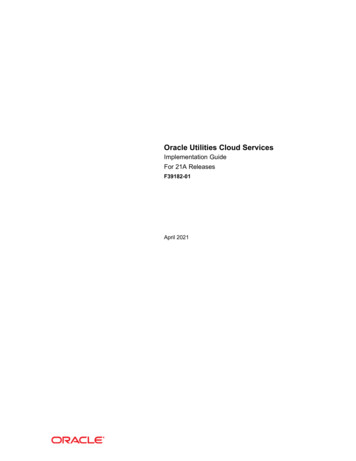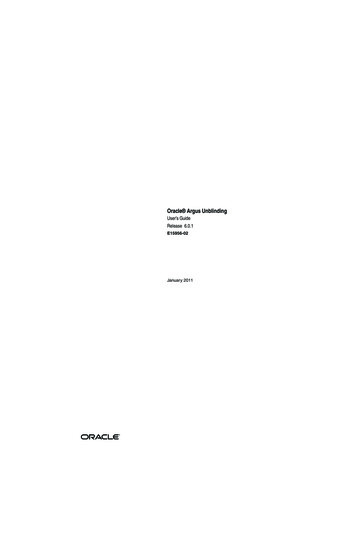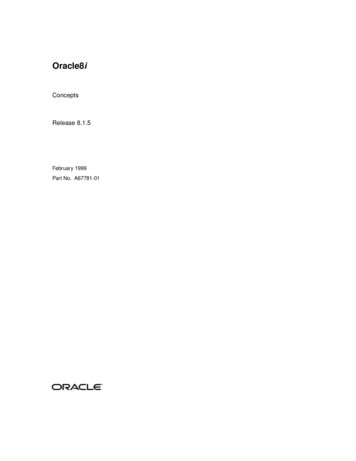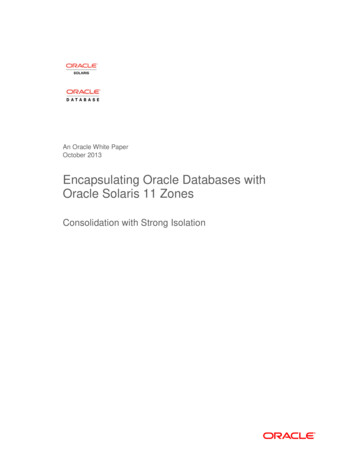
Transcription
Oracle Utilities Cloud ServicesImplementation GuideFor 21A ReleasesF39182-01April 2021
Oracle Utilities Customer Cloud Services 21A Integration GuideCopyright 2017, 2021 Oracle and/or its affiliates. All rights reserved.This software and related documentation are provided under a license agreement containing restrictions onuse and disclosure and are protected by intellectual property laws. Except as expressly permitted in yourlicense agreement or allowed by law, you may not use, copy, reproduce, translate, broadcast, modify, license,transmit, distribute, exhibit, perform, publish, or display any part, in any form, or by any means. Reverseengineering, disassembly, or decompilation of this software, unless required by law for interoperability, isprohibited.The information contained herein is subject to change without notice and is not warranted to be error-free. Ifyou find any errors, please report them to us in writing.If this is software or related documentation that is delivered to the U.S. Government or anyone licensing it onbehalf of the U.S. Government, then the following notice is applicable:U.S. GOVERNMENT END USERS: Oracle programs (including any operating system, integrated software,any programs embedded, installed or activated on delivered hardware, and modifications of such programs)and Oracle computer documentation or other Oracle data delivered to or accessed by U.S. Government endusers are "commercial computer software" or "commercial computer software documentation" pursuant tothe applicable Federal Acquisition Regulation and agency-specific supplemental regulations. As such, the use,reproduction, duplication, release, display, disclosure, modification, preparation of derivative works, and/oradaptation of i) Oracle programs (including any operating system, integrated software, any programsembedded, installed or activated on delivered hardware, and modifications of such programs), ii) Oraclecomputer documentation and/or iii) other Oracle data, is subject to the rights and limitations specified in thelicense contained in the applicable contract. The terms governing the U.S. Government's use of Oracle cloudservices are defined by the applicable contract for such services. No other rights are granted to the U.S.Government.This software or hardware is developed for general use in a variety of information management applications.It is not developed or intended for use in any inherently dangerous applications, including applications thatmay create a risk of personal injury. If you use this software or hardware in dangerous applications, then youshall be responsible to take all appropriate fail-safe, backup, redundancy, and other measures to ensure its safeuse. Oracle Corporation and its affiliates disclaim any liability for any damages caused by use of this softwareor hardware in dangerous applications.Oracle and Java are registered trademarks of Oracle and/or its affiliates. Other names may be trademarks oftheir respective owners.Intel and Intel Inside are trademarks or registered trademarks of Intel Corporation. All SPARC trademarks areused under license and are trademarks or registered trademarks of SPARC International, Inc. AMD, Epyc, andthe AMD logo are trademarks or registered trademarks of Advanced Micro Devices. UNIX is a registeredtrademark of The Open Group.This software or hardware and documentation may provide access to or information about content, products,and services from third parties. Oracle Corporation and its affiliates are not responsible for and expresslydisclaim all warranties of any kind with respect to third-party content, products, and services unless otherwiseset forth in an applicable agreement between you and Oracle. Oracle Corporation and its affiliates will not beresponsible for any loss, costs, or damages incurred due to your access to or use of third-party content,products, or services, except as set forth in an applicable agreement between you and Oracle.
ContentsChapter 1Introduction . 1-1Part OneImplementation GuidelinesChapter 2Security and Access. 2-1Identity Management . 2-2Use of Identity Cloud Service . 2-2User Provisioning with Oracle Identity Cloud Service . 2-2Server Access. 2-2Chapter 3Configuration Tools. 3-1Customization Tools Summary . 3-2Algorithm Types and Algorithms . 3-3Application Environments. 3-4Environment Names and Codes . 3-4Application / Environment Access and URL Tokens. 3-4Creating Batch Processes. 3-6Chapter 4Data Conversion Guidelines . 4-1Data Conversion Approach . 4-1Data Conversion Tips. 4-1Chapter 5Integration Guidelines . 5-1Integration Methods. 5-2Integration Method: File-Based . 5-2Integration Method: Web Services . 5-2Integration Middleware. 5-3Integration Middleware: Oracle Integration Cloud (OIC). 5-3Integration Middleware: SOA Cloud Service (SOACS) - PaaS. 5-3Integration Middleware: SOA Suite On-Premises . 5-3Allowlisting . 5-4IP Allowlisting . 5-4Chapter 6Operational Guidelines . 6-1Batch Job Submission . 6-2Batch Job Scheduling . 6-2Using Oracle DBMS Scheduler. 6-2Level of Service Batch Monitoring . 6-3Code and Configuration Migration. 6-4Contents - 1Oracle Utilities Cloud Services Implementation Guide
What is Cloud Service Foundation? . 6-4Customer Facing Alerts . 6-4Data Fix with Plug-in Driven Batch . 6-5Data Cloning/Subsetting. 6-5Full Volume - Clone . 6-5Partial Volume - Subset. 6-6Information Lifecycle Management / Archiving. 6-6Limits on Time or Size of Certain Services . 6-6Server Logs - Online and Batch . 6-7Cloud Service Release Management . 6-7Software Releases & Updates. 6-7Infrastructure Updates. 6-8Maintenance Packs (First 3-4 months of release). 6-8Hotfixes for Critical Issues . 6-8Regression Testing through Utilities Testing Accelerator. 6-9Chapter 7Data Access and Analytics. 7-1Analytics/BI Publisher . 7-2Database Access. 7-2Reports and Queries. 7-2File Access - Cloud Object Storage . 7-3Uploading and Downloading File To and From Object Storage . 7-3Part TwoData Upload SupportChapter 8Data Upload Support Overview. 8-1Conversion Process Overview. 8-2Implementation Effort . 8-3What Is in the Newly Provisioned Environment?. 8-4Chapter 9Data Upload Support On Cloud . 9-1Overview. 9-2Provided by Cloud Service Foundation . 9-3Provided by Applications .9-4Application Conversion Tool. 9-4Application Accelerators . 9-4Chapter 10Data Upload Design . 10-1Extract/Upload by Table or Maintenance Object .10-2CLOB Data in a Secondary File .10-3Multiple Data Files for Single Table or MO Upload . 10-3Chapter 11Preparing for Conversion. 11-1Preparing Environment for Conversion .11-2Set Up Conversion Security. 11-2Prepare Environment for Conversion . 11-2Preparing Legacy Data Extract for Upload .11-4ILM Date Fields . 11-6Chapter 12Data Upload Steps . 12-1Upload Data into a Table or Maintenance Object .12-2Review Input Data File Spec . 12-2Create Input Data File(s). 12-2Contents - 2Oracle Utilities Cloud Services Implementation Guide
Switch Schema . 12-2Cleanup Target Table . 12-3Upload Data. 12-3Populate Key Table(s) . 12-3Data Upload Orchestration.12-4Single Table Upload. 12-4Multiple Tables or MOs Upload. 12-4Full Conversion Chain per MO, Parallel Run. 12-5Upload All Subsequent Validate/Transform MOs. 12-5Chapter 13Customizing Data Upload . 13-1Why Customize.13-2When to Customize. 13-2What to Customize. 13-2Control File . 13-2Additional Customization Items. 13-3How to Customize . 13-3Tips and Important Mistakes to Avoid . 13-4Sample Artifacts and Data Files . 13-6Part ThreeFile-Based IntegrationChapter 14Object Storage Connection Management . 14-1Oracle Object Storage Setup.14-2Oracle Utilities Cloud Service Configuration for Object Storage Connection . 14-2Creating API Keys . 14-2Creating An Object Storage Connection. 14-3Register API Key to Oracle Cloud Object Storage. 14-4Chapter 15File Export Sample Implementation . 15-1Creating a File Export Batch Process.15-2Configuring the Export Process.15-3Setting Up Communication Between Cloud Service and Object Storage. 15-3Configuring File Export Batch Parameters. 15-3Testing the Export Process . 15-4Chapter 16File Import Sample Implementation . 16-1Identifying Upload File Content Data.16-2Uploading File to Oracle Cloud Object Storage. 16-2Creating a File Import Batch Process.16-3Plug-In Script . 16-3Algorithm Type and Algorithm . 16-3File Upload Batch Control. 16-3Configuring the Import Process. 16-4Setting Up Communication Between Cloud Service and Object Storage. 16-4Configuring File Import Batch Controls. 16-4Testing the Import Process . 16-5Part FourOracle REST Data ServicesChapter 17SQL Developer Web . 17-1Contents - 3Oracle Utilities Cloud Services Implementation Guide
Chapter 18REST APIs. 18-1Part FiveProduct-Specific IntegrationsChapter 19Customer Cloud Service Receipt Printing. 19-1Printer Installation .19-2Oracle Utilities Cloud Services Configuration . 19-2Configuring the Point of Sale Printer Integration Master Configuration. 19-2Configuring and Updating UI Maps and BPA Scripts . 19-3Configuring and Updating Tender Sources . 19-6Contents - 4Oracle Utilities Cloud Services Implementation Guide
Chapter 1IntroductionThis document provides information about implementation of Oracle Utilities cloudservice, including: Oracle Utilities Billing Cloud Service Oracle Utilities Customer Cloud Service Oracle Utilities Meter Solution Cloud Service Oracle Utilities Operational Device Cloud Service Oracle Utilities Rate Cloud Service Oracle Utilities Work and Asset Cloud ServiceThe topics described in this document include: Part One: Implementation Guidelines Part Two: Data Upload Support Part Three: File-Based Integration Part Four: Oracle REST Data Services Part Five: Product-Specific IntegrationsIntroduction 1 - 1Oracle Utilities Cloud Services Implementation Guide
Part OneImplementation GuidelinesThis section describes global implementation guidelines that apply to all Oracle Utilitiescloud services running on Oracle Cloud Infrastructure (OCI), which includes Oracle Utilities Billing Cloud Service Oracle Utilities Customer Cloud Service Oracle Utilities Meter Solution Cloud Service Oracle Utilities Operational Device Cloud Service Oracle Utilities Rate Cloud Service Oracle Utilities Work and Asset Cloud ServiceNote that these cloud services are all based on the Oracle Utilities ApplicationFramework (OUAF), which supports many different configuration and extensionmethods, almost all of which are available for use in the cloud. This section providesrecommendations for many aspects of set-up and operation of the services. Note that itassumes familiarity with OUAF concepts and tools.In a nutshell, the top cloud service implementation rules to be aware of are the following: Use Groovy code in Scripts (not Java) Use existing data structures to extend the base model - such as Characteristicsand the Fact table Use plug-in driven batch can be used in many scenarios for data fixes - this willensure proper data validationThe guidelines in this are intended to help implementers to configure and run their cloudservices efficiently.This section include the following chapters: Chapter 2: Security and Access Chapter 3: Configuration Tools Chapter 4: Data Conversion Guidelines Chapter 5: Integration Guidelines Chapter 6: Operational Guidelines Chapter 7: Data Access and AnalyticsImplementation Guidelines 1 - iOracle Utilities Cloud Services Implementation Guide
Chapter 2Security and AccessThis chapter provides implementation guidelines related to security and access, including: Identity Management Server AccessSecurity and Access 2 - 1Oracle Utilities Cloud Services Implementation Guide
Identity ManagementIdentity ManagementUse of Identity Cloud ServiceIn Oracle Cloud Infrastructure, cloud services are provisioned using Oracle IdentityCloud Service (IDCS) to manage user creation, application access, passwords, etc. Thisservice at the 'Foundation' tier is included with the Oracle Utilities cloud servicesubscription. See Administering Oracle Identity Cloud Service for more information onIDCS.By default Oracle Identity Cloud Service allows access to the application front-end fromany IP address. There are capabilities in IDCS to add sign-on policies that allow or denyIP addresses through the use of allowlists (though some features may require 'Standard'tier licensing).User Provisioning with Oracle Identity Cloud ServiceApplication users are added through Oracle Identity Cloud Service, which manages theuser lifecycle (i.e. you can disable a user
Cloud Service (IDCS) to manage user creation, application access, passwords, etc. This service at the 'Foundation' tier is included with the Oracle Utilities cloud service subscription. See Administering Oracle Identity Cloud Service for more information on IDCS. By default Oracle Identity Cloud Service allows access to the application front .











